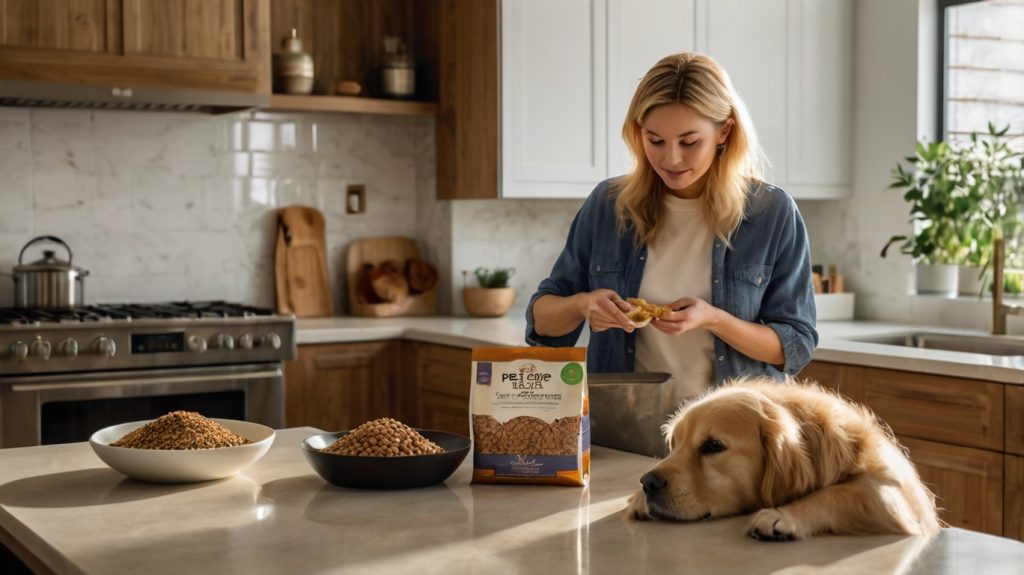If your dog frequently experiences diarrhea, vomiting, gas, or loss of appetite, they likely suffer from sensitive stomach syndrome. According to the American College of Veterinary Internal Medicine, over 20% of household dogs experience varying degrees of digestive system sensitivity. Choosing the right dog food can not only alleviate these symptoms but help your beloved pet regain their health and vitality.
This comprehensive guide provides scientific, practical advice to help you find the most suitable food solution for dogs with sensitive stomachs. From ingredient analysis and brand comparisons to practical feeding recommendations, we’ll provide expert guidance covering every aspect you need to know.
In-Depth Analysis: Root Causes of Canine Stomach Sensitivity
Identifying Common Symptoms
Dogs with sensitive stomachs typically display the following symptoms:
- Digestive Issues: Frequent soft stools or diarrhea (more than 3 times per week)
- Gastrointestinal Distress: Vomiting, dry heaving, or regurgitation after eating
- Behavioral Changes: Decreased appetite, lethargy, abdominal pain
- Skin Problems: Food allergy-induced rashes or itching

Root Cause Analysis
Research from Cornell University College of Veterinary Medicine shows that canine stomach sensitivity is primarily caused by:
- Food Allergies or Intolerances (45%): Allergic reactions to specific proteins or carbohydrates
- Gut Microbiome Imbalance (25%): Insufficient beneficial bacteria, excessive harmful bacteria
- Genetic Factors (20%): Some breeds naturally have weaker digestive systems
- Environmental Stress (10%): Environmental changes, emotional stress, and other factors
Supporting Data
The American Pet Food Association’s 2023 survey reveals:
- 68% of pet owners report being troubled by their dog’s digestive problems
- After switching to specialized sensitive stomach dog food, 89% of cases showed significant improvement within 4-6 weeks
- Dogs fed appropriate food showed 35% improvement in long-term health levels
Scientific Solutions: 5 Key Selection Criteria Explained
Criterion 1: High-Quality Single Protein Source
Why It’s Important: Single protein sources minimize allergy risks and make it easier to identify allergens.
Specific Requirements:
- Choose low-allergen proteins like lamb, duck, or fish
- Protein content should be controlled between 22-26%
- Avoid common allergens like chicken or beef
Recommended Ingredients: Deboned lamb, salmon meal, duck meal, etc.
Important Notes: Carefully check ingredient lists to ensure no mixed meat proteins
Criterion 2: Easily Digestible Carbohydrates
Scientific Basis: Complex carbohydrates are difficult to digest and can burden the digestive system.
Best Choices:
- Sweet Potato: Rich in dietary fiber, promotes intestinal motility
- Pumpkin: Contains abundant β-carotene with anti-inflammatory properties
- Brown Rice: Provides stable energy without causing blood sugar fluctuations
Ingredients to Avoid: Corn, wheat, soy, and other potentially allergenic grains
Criterion 3: Added Probiotics and Prebiotics
Mechanism of Action: Probiotics help establish healthy gut flora, while prebiotics provide nutrition for beneficial bacteria.
Key Strains:
- Lactobacillus acidophilus
- Bifidobacterium animalis
- Enterococcus faecium
Recommended Content: Each kilogram of dog food should contain at least 10^8 CFU of active probiotics
Criterion 4: Natural Digestive Enzymes
Importance: Help break down proteins, fats, and carbohydrates, reducing digestive burden.
Core Enzymes:
- Protease: Breaks down proteins
- Lipase: Breaks down fats
- Amylase: Breaks down starches
Criterion 5: Omega-3 Fatty Acids for Anti-Inflammatory Effects
Scientific Foundation: EPA and DHA have potent anti-inflammatory properties that can reduce intestinal inflammation.
Ideal Sources: Fish oil, flax seed oil, algae oil Recommended Ratio: Omega-6 to omega-3 ratio should be controlled between 5:1 to 10:1
Practical Tools & Resource List
Digestive Health Monitoring Tools
Symptom Record Chart: Recommended professional pet health apps to track:
- Daily bowel movement frequency and consistency
- Appetite changes
- Vomiting frequency and timing
- Mental state assessment
Recommended Apps:
- PetDesk (Free, supports symptom tracking)
- Whistle Health ($9.99/month, includes professional analysis)
Transition Period Feeding Plan
7-Day Scientific Transition Method:
- Days 1-2: New food 25% + Original food 75%
- Days 3-4: New food 50% + Original food 50%
- Days 5-6: New food 75% + Original food 25%
- Day 7: 100% new food
Professional Consultation Resources
Online Veterinary Consultation Platforms:
- Chewy Connect (24-hour service)
- Petco Love Vet Care (Professional gastroenterology specialists)
Nutritionist Consultation Services:
- Royal Canin Pet Nutritionist Hotline: Available weekdays
- Hill’s Professional Nutrition Consultation: Tuesdays and Thursdays, 2-5 PM
Emergency Response Guide
Severe Symptom Recognition (Requires immediate veterinary care):
- Refuses food for 24 consecutive hours
- Blood in stool or black stool
- Continuous vomiting for more than 6 hours
- Obvious dehydration symptoms
Summary & Action Guide
Key Points Recap
Choosing suitable dog food for dogs with sensitive stomachs focuses on:
- Simple Ingredients: Choose single protein sources, avoid complex formulas
- Easy Digestibility: Prioritize easily digestible carbohydrates like sweet potato and pumpkin
- Functional Additions: Probiotics, digestive enzymes, and omega-3 fatty acids are essential
- Scientific Transition: Strictly follow the 7-day transition plan when changing food
- Continuous Monitoring: Record symptom changes, adjust feeding plan promptly

Immediate Action Recommendations
Step 1: Consult a veterinarian to confirm the specific cause of your dog’s stomach sensitivity Step 2: Based on this article’s criteria, select 2-3 candidate dog foods for comparison Step 3: Create a detailed transition feeding plan and prepare symptom record sheets Step 4: Begin implementing the new feeding regimen, closely observe your dog’s response
Remember, every dog’s situation is unique. While this article provides a scientific selection framework, final decisions should combine your dog’s specific circumstances with professional veterinary advice. With proper selection, your beloved pet will soon regain health and vitality, enjoying delicious meal times.
Important Reminder: If symptoms persist or worsen, please consult a professional veterinarian immediately. Don’t rely solely on dietary adjustments to resolve serious health issues.